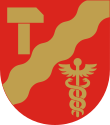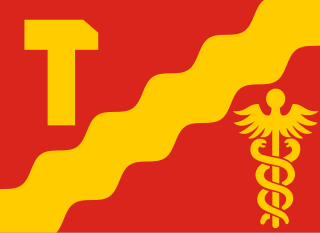
Tampere is a city in Finland and the regional capital of Pirkanmaa. It is located in the Finnish Lakeland. The population of Tampere is approximately 255,000, while the metropolitan area has a population of approximately 417,000. It is the 3rd most populous municipality in Finland, and the second most populous urban area in the country after the Helsinki metropolitan area.
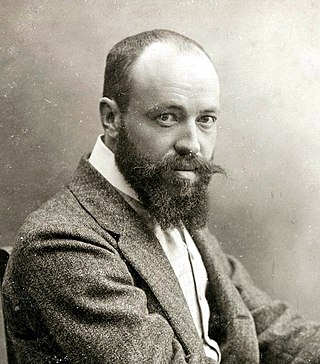
Hugo Gerhard Simberg was a Finnish symbolist painter and graphic artist.
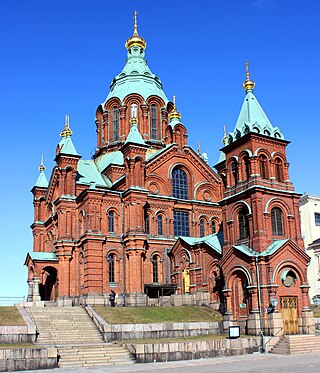
The Orthodox Church of Finland or Finnish Orthodox Church is an autonomous Eastern Orthodox archdiocese of the Ecumenical Patriarchate of Constantinople. The church has a legal position as a national church in the country, along with the Evangelical Lutheran Church of Finland.

Lars Eliel Sonck was a Finnish architect. He graduated from Helsinki Polytechnic Institute in 1894 and immediately won a major design competition for a church in Turku, St Michael's Church, ahead of many established architects. The church was designed in the prevailing neo-Gothic style. However, Sonck's style would soon go through a dramatic change, in the direction of Art Nouveau and National Romanticism that was moving through Europe at the end of the 19th century. During the 1920s, Sonck would also design a number of buildings in the emerging Nordic Classicism style.

Porvoo Cathedral is a cathedral of the Evangelical Lutheran Church of Finland in Porvoo, Finland. It was built in the 15th century, although the oldest parts date from the 13th century. It is the seat of the Diocese of Borgå, Finland's Swedish-speaking diocese. The cathedral is also used for services by the Porvoo Finnish-speaking parish, which is administratively part of the Diocese of Helsinki. The church first became a cathedral in 1723, when the diocese of Viipuri (Viborg) moved to Porvoo, after Vyborg was ceded to Russia in the Treaty of Nystad.
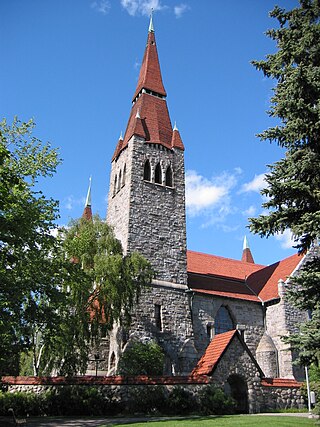
The Diocese of Tampere is the second oldest and the largest diocese in the Evangelical Lutheran Church of Finland. It is divided into 69 parishes with a total population of over 595,000 people. The diocese is led by the Bishop of Tampere.

Kaleva Church is an Evangelical Lutheran Church of Finland church building in the Liisankallio district of Tampere, Finland. It was designed by Reima and Raili Pietilä and built in 1964–66. The church accommodates approximately 1,120 people. It is considered an example of modern architectural style and is one of the main sights of Tampere.

The Wounded Angel is a painting by Finnish symbolist painter Hugo Simberg. It is one of the most recognizable of Simberg's works, and was voted Finland's "national painting" in a vote held by the Ateneum art museum in 2006. In a similar 2013 vote held by Nordic Moneta, it was voted second most important.

The Garden of Death is a painting by Finnish symbolist painter Hugo Simberg. Like many of Simberg's paintings, it depicts a gloomy, otherworldly scene. The central figures are reminiscent of the classic black-clad Grim Reaper, but paradoxically are tending to gardens; traditionally symbols of birth or renewal.

The Tampere light rail, branded as Tampere Tram, is a public transport system in Tampere, Finland. In November 2016, the Tampere city council approved plans to construct a 330-million-euro light rail system on the route from the city centre to Hervanta and to the Tampere University Hospital. Traffic on the first two lines of the route began on 9 August 2021.

Michael's Church is a church situated in central Turku. It is named after Archangel Michael and was finished in 1905. It dominates the western skyline of the city of Turku. It was designed by Professor Lars Sonck and is one of the most popular wedding churches in Turku, being able to seat 1,800 people. When Sonck won the competition for the church in 1894, he was only a 23-year-old architectural student. Michael's Church is older than Michael's parish. The parish only dates back to 1921.

The Finlayson Church is a church built in Gothic Revival style located in the Finlayson industrial area in the district by the same name in Tampere, Finland. It was built in 1879 as the church of the Finlayson cotton factory, where the factory workers could practice religion. Currently the church belongs to the Evangelical-Lutheran congregations of Tampere, and it is used as a children's road church and a popular church for weddings.

Finnish art started to form its individual characteristics in the 19th century, when romantic nationalism began to rise in the autonomous Grand Duchy of Finland.

Mikael Agricola Church is a Lutheran church located in the Punavuori district of Helsinki, Finland. It was designed by Lars Sonck and built between 1933 and 1935. The church was inaugurated on 14 April 1935. It is named after bishop Mikael Agricola.
Art Nouveau temples are churches, chapels, synagogues, and mosques built in the style known as Art Nouveau in French and English languages, Jugendstil in Germany and Nordic countries, Secessionsstil in countries of former Austro-Hungary, Modernisme in Catalan, Modern in Russian, Stile Liberty or Stile Floreale in Italian. As National Romantic style is also referred to Art Nouveau, churches of that style are also listed here, as well as some temples not of pure Art Nouveau style but with distinctive Art Nouveau features.
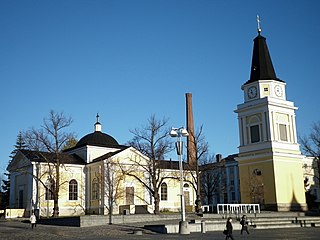
The Tampere Old Church is a wooden cross church opened in 1825 in Tampere, Finland near the Central Square. The old church is mainly used by the Swedish-speaking Lutheran congregation in Tampere. The church was designed by Italian-born Carlo Bassi and completed in 1824. The belfry, designed by C. L. Engel, was completed in 1828. The Old Church is the oldest surviving building in the city center of Tampere, and the adjoining belfry is the second oldest.

The Alexander Church is a stone church in Tampere, Finland, and it is part of the Tampere Cathedral Parish. It is located in the Kaakinmaa district in the city center of Tampere, on the edge of the Hämeenpuisto park along the Pirkankatu street. The church, designed by architect Theodor Decker, was built of brick between 1880 and 1881. It is named after Emperor Alexander II of Russia. The church is surrounded by Pyynikki Church Park, a former cemetery.

Tuomiokirkonkatu is a north–south street in the center of Tampere, Finland, which runs through the districts of Jussinkylä and Kyttälä. The street is about a kilometer long. In the north it ends at Lapintie, in the south Vuolteenkatu. In Kyttälä, part of Tuomiokirkonkatu has been turned into a pedestrian street. In the future, the pedestrian section will be expanded so that it will eventually extend south from Kyttälänkatu to Suvantokatu and the Sori Square.

Pyynikinrinne is a district of Tampere, Finland. It is located west of the city center. Pyynikinrinne is bordered on the south by the Pyynikki Esker nature reserve, on the north by Pirkankatu and on the east by Mariankatu. The western boundary of the district is the former border between Tampere and Pohjois-Pirkkala municipalities. The neighboring parts of the city are Pyynikki, Ylä-Pispala, Amuri, partly Särkänniemi and Kaakinmaa.
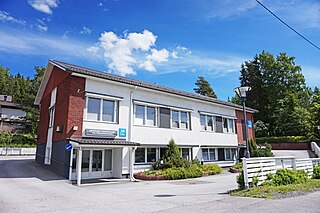
Epilänharju is a district of Tampere, Finland. The district is bordered on the north by Lamminpää, on the east by Lielahti, on the south by Epilä and on the west by Tohloppi and Ristimäki. The Epilänharju district is home to the former Epilä Spa, which has now been abandoned and left to decay, as well as Abloy Oy's former factory.





















